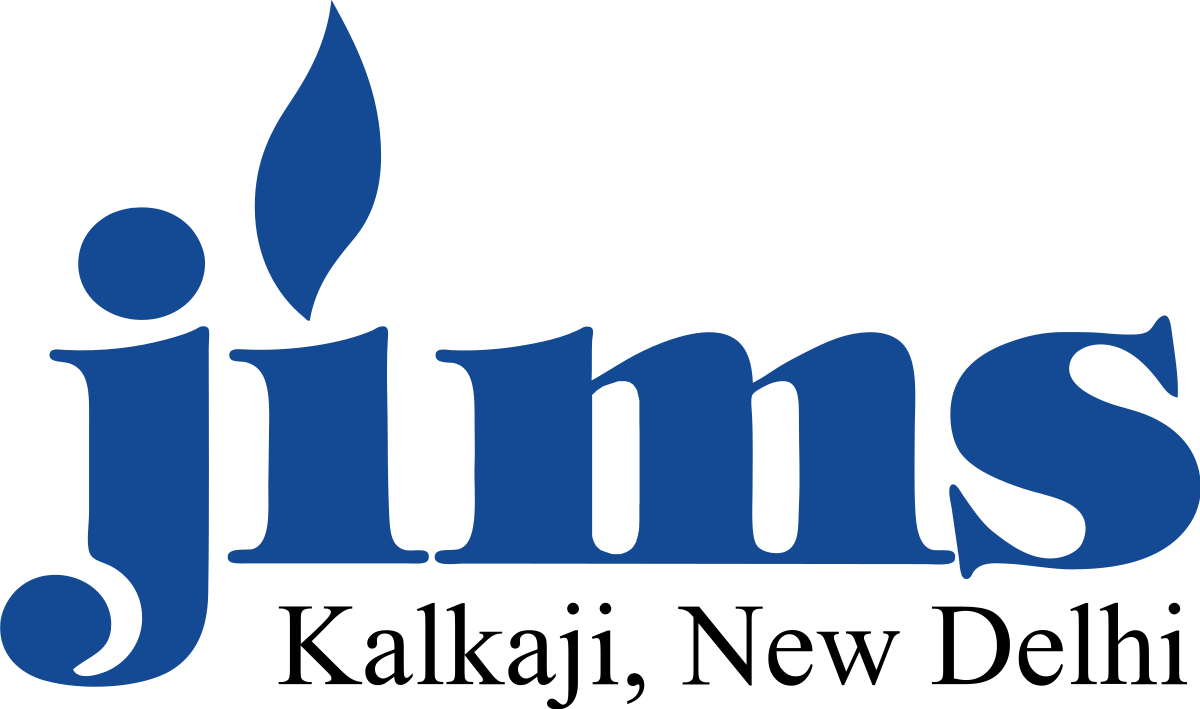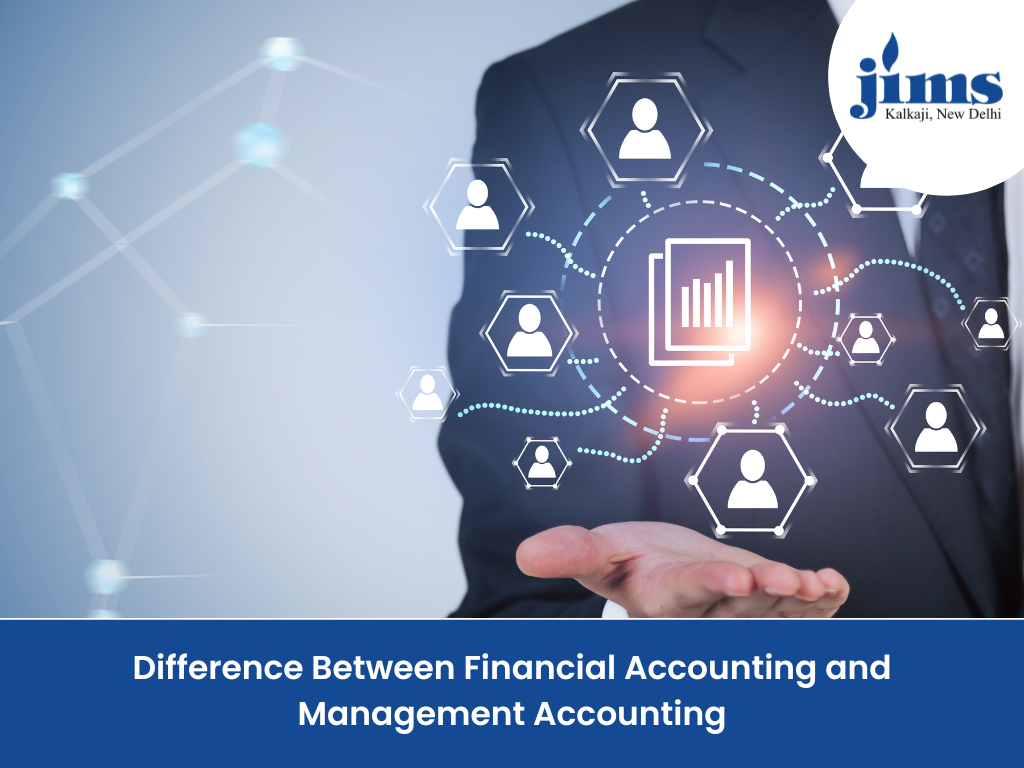Business and financial management has a strong foundation in the form of accounting that guarantees a scientific process of recording, classifying, and analyzing accounting information. Not all forms of accountancy are developed with a particular duty or client base. Two most important branches among others are cost accounting and financial accounting. Though both account for a corporation’s finances, they differ in their domains they cover, parties they serve, and different accounting practices they ensure.
This piece will delve into fundamental distinctions between cost accounting and financial accounting, including their definitional scope, purposes, objectives, reporters, coverage, as well as methods. JIMS Kalkaji, one of the best MBA college in Delhi, also highlights the importance of understanding these key accounting practices for students aiming to excel in the world of business and finance.
What is Financial Accounting and Cost Accounting – Understanding through definitions
Financial Accounting involves accounting for, aggregation, and external disclosure of a corporation’s economic occurrences according to prescribed principles of accounting either Generally Accepted Accounting Principles (GAAP) or International Financial Reporting Standards (IFRS). Financial accounting produces a comprehensive representation of a corporation’s position within a specified duration and is essentially about preparing external financial reports such as the balance sheet, income statement, and cash flow statement.
Cost Accounting, however, is a specialty area of accounting dealing with the measurement, capture, and analysis of costs of producing goods or services. It entails the quantification of costs of materials, labor, overhead, as well as other costs incurred in the production process. Cost accounting is concerned with generating descriptive information to assist internal management with budgeting, pricing, cost management, as well as decision-making.
Purpose
-
Financial Accounting is to provide a true and comprehensive account of a corporation’s overall financial performance and position to external stakeholders such as investors, lenders, government regulators, and taxing authorities. It is to present a brief picture of profitability, assets, debts, and cash flow.
-
Cost Accounting deals with internal business operations and is meant to help management arrive at decisions. It helps with cost monitoring as well as their controls, creating budgets, setting a price for products or services, and improving efficiency. Cost accounting also provides information to assess whether or not a business is generating a profit or where costs should be decreased.
Users
-
Financial Accounting is utilized directly by external users including:
-
Shareholders and investors who assess profitability and performing companies.
-
Creditors, banks, and lenders who evaluate the creditworthiness of the corporation.
-
Regulators (e.g., Securities and Exchange Commission, taxing authorities) who demand observance with laws and rules.
-
Business researchers who assess where the company is placed in the market.
-
-
Cost Accounting is applied mostly by internal users including:
-
Cost managers who make decisions regarding pricing, production, and investments using cost data.
-
Department managers who evaluate individual costs related to their departments and aim to maximize operational efficiency.
-
Cost controllers and accountants seeking waste reduction and value for money.
-
Cost-using managers who take into consideration cost information to determine enterprise profitability as well as make strategic decisions.
-
Reporting Format and Frequency
-
Financial Accounting follows standardized reporting formats as per regulations, including balance sheets, income statements, and cash flow statements. These reports follow universally accepted accounting standards (such as GAAP or IFRS) to ensure consistency, comparability, and transparency. Financial statements are typically prepared annually or quarterly and are subject to external audits for accuracy and compliance.
-
Cost Accounting, on the other hand, is more responsive to reporting. Reports can be highly tailored to suit the requirements of management or can contain details regarding production costs, overhead costs, variable costs, fixed costs, as well as break-even points. These reports can be produced as often as necessary—monthly, weekly, or even daily—in order to present management with real-time information.
Scope
-
Financial Accounting has a wider scope since it encompasses the capturing of all the financial transactions within the entire organization such as revenue, expenditure, assets, liabilities, and equity. It aims to offer a comprehensive financial picture to the outside parties.
-
Cost Accounting has a narrower scope, i.e., only dealing with costs that are incurred to produce goods or services. Cost accounting deals with monitoring, analyzing, and controlling cost structure within an enterprise, i.e., cost of raw materials, labor, manufacturing overheads, etc., and other direct/indirect costs related to production.
Time Orientation
-
Financial Accounting is historical. It is about recordkeeping of events and transactions that occurred in the past to capture a corporation’s economic activity within some defined period of time (quarterly or annually most frequently). These reports generated are backward-looking summaries of prior activity.
-
Cost Accounting, however, is forward-looking and is about helping management with planning, budgeting, and forecasting future expenditures. Cost accounting is furthermore not only about analysing current costs but also provides informative data about cost behaviour and patterns to optimize future operations as well as make better strategic decisions.
Regulatory Requirements
-
Financial Accounting is strictly controlled. It is mandatory to abide by standard account principles, i.e., GAAP, IFRS, or any other local rules that might be applicable. These guidelines make the financial reports comparable as well as transparent to third parties. It is also subject to external audit to validate that reports are correct as well as compliant.
-
Cost Accounting is not regulated by an external agency. Although an enterprise or a department can set inner norms about cost measurement as well as cost control, neither rules nor any guidelines are enforced to be followed. Cost account reports are generated so as to support internal management’s needs but they cannot be submitted to external audit.
Types of Reports
-
Financial Accounting reports consist of:
-
Income Statement (Profit and Loss Statement): Consolidates a corporation’s revenues and costs/expenses over a specific period to establish profitability.
-
Balance Sheet: It is a summary of assets, current liabilities, non-current liabilities, and equity as of a specific date.
-
Cash Flow Statement: Shows the inflow and outflow of cash of the corporation from operating, investing, and financing activities.
-
-
Cost Accounting reports would contain:
-
Cost Sheets: Indicate total cost of production with breakdown into direct costs and indirect costs.
-
Budget Reports: Help in forecasting costs for the future and tracking performance against the budget.
-
Break-even Analysis: It indicates where a firm’s revenue would be equal to costs.
-
Variance Analysis: It compares anticipated costs with Actual costs to investigate variances and take corrective measures.
-
Reports for Cost Controls: Help to track cost trends and where cost savings could be made.
-
Focus Area
-
Financial Accounting is concerned with accuracy, transparency, and compliance. It is intended to present a correct and complete financial picture to external parties regarding the enterprise with an eye towards being compliant with regulatory standards. Financial accounting deals with broad-based enterprise operations and is compliant with prescribed reporting norms.
-
Cost Accounting is all about efficiency, control over costs, and optimisation. It is intended to facilitate internal management to make right decisions concerning cost management, usage of resources, as also pricing strategies. Cost accounting attempts to reveal cost reduction opportunities as also operational efficiency.
Nature of Information
-
Financial Accounting produces numeric data regarding the overall fiscal status of the corporation. It covers information including revenue, profit, assets, debt, and equity. Such information is disclosed in standardized financial statements that are also authenticated to validate their correctness.
-
Cost Accounting yields both numerical as well as descriptive data. Cost accounting numbers could be raw materials costs or labour costs or production overhead costs, but descriptive data could be insights regarding cost behaviour or production inefficiencies or cost change patterns.
Table: Distinguishing Between Cost Accounting and Financial Accounting
| Factor | Cost Accounting | Financial Accounting |
|---|---|---|
| Purpose | To help internal management in decision-making | To provide external stakeholders with accurate financial information |
| Users | Internal users (management, department heads, etc.) | External users (investors, creditors, regulators) |
| Focus Area | Cost control, efficiency, budgeting, pricing | Overall financial position and performance |
| Reports | Cost sheets, budget reports, variance analysis, break-even analysis | Income statement, balance sheet, cash flow statement |
| Time Orientation | Forward-looking (future-oriented) | Historical (past-oriented) |
| Regulation | Not regulated by external bodies | Strictly regulated by GAAP/IFRS and external audits |
| Scope | Narrower (focuses on production costs) | Broader (encompasses all financial transactions) |
| Frequency of Reporting | Monthly, weekly, or daily | Annually or quarterly |
| Type of Data | Both quantitative and qualitative | Quantitative (numerical) |
Conclusion
Whereas both cost accounting and financial accounting are valuable branches of accounting, they have significantly different roles to fulfill within an enterprise. Financial accounting provides a transparent historical picture of a corporation’s financial status to outsiders, but cost accounting provides intricate information about a corporation’s inner workings so management can keep costs within boundaries to establish budgets and make strategic plans.
-
Financial Accounting: Past, external emphasis, standardized reports, compliance with rules.
-
Cost Accounting: Prospective-looking, internal decision-making, flexible reports, absence of governing controls.
Simply speaking, financial accounting assists firms to conduct business with the external world, while cost accounting assists firms to function efficiently internally. Both facilitate a firm’s overall effectiveness with clarity as well as internal functional excellence.
FAQs
-
What seem to be the connections among cost and financial accounting?
-
Both cost accounting and financial accounting provide essential financial insights but serve different purposes. Cost accounting helps internal management make informed decisions about cost control and operational efficiency, while financial accounting provides external stakeholders with a complete picture of the company’s financial position.
-
-
What exactly is a financial accounting example?
-
A financial accounting example would be the preparation of an income statement that summarizes a company’s revenues and expenses over a given period to determine its profitability, which is then reported to external users like investors or regulatory bodies.
-
-
What is the function of cost accounting?
-
Cost accounting helps organizations track, analyze, and control the costs of production. It provides detailed information on material costs, labour costs, overheads, and other production-related expenses to help management make informed decisions about pricing, budgeting, and cost reduction strategies.
-
-
What are the benefits of financial accounting?
-
Financial accounting ensures transparency, compliance with regulations, and provides accurate financial data to external stakeholders for decision-making. It helps investors assess the financial health of a company, provides tax authorities with necessary data, and ensures accountability.
-
-
What are the benefits of cost accounting?
-
Cost accounting helps businesses control and reduce costs, optimize pricing, improve profitability, and make strategic decisions based on detailed cost information. It also assists in budgeting and financial planning, helping to align operational costs with company goals.
-

